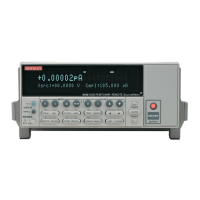Quick Results Guide 15
Offset-compensated ohms
Thermal EMFs can corrupt low-resistance measurements. An offset-compensated
measurement cancels out unwanted offset by performing the following 2-point
measurement process:
Offset-Compensated = V / I
where: V = V2 - V1
I = I2 - I1
V1 and I1 are V and I measurements with the source set to a specific level.
V2 and I2 are V and I measurements with the source set to zero.
1. Select the function, and select the auto or manual ohms measurement method.
2. Enable offset compensation by using the following menu sequence:
Press CONFIG > press MEAS > select OFFSET COMPENSATION > select
ENABLE
3. If using auto ohms, go to the next step. For manual ohms, configure the desired source
(V or I) to output an appropriate source level. Set compliance and select a measurement
range (or use auto range).
4. Turn the output on and observe the offset-compensated ohms reading on the display.
Note that the source value alternates between the set output level and zero.
5. When finished, turn the output off and disable offset compensation.
NOTE Manual offset-compensated ohms is also available as a math function (FCTN). This
math function allows you to specify both source levels (see “Math functions” in
“Features to enhance DUT testing.”
Remote command programming
Data string
The :READ? command is typically used to trigger a source-measure action and request the
data string. The data string is sent to the computer when the SourceMeter is addressed to talk.
The data string is typically made up of five elements separated by commas. The first element
is the voltage reading, the second is the current reading, and the third is the resistance
reading. For voltage and current, the reading could be source or measure depending on how
the instrument is configured. For example, if sourcing voltage and measuring current, the
voltage element is the source reading and the current element is the measured reading. The
NAN (not a number) value of +9.91e37 is used for a function that is not enabled.
The fourth data element is the timestamp and the fifth is the status word. See Section 17,
FORMat subsystem, of the Model 6430 Instruction Manual for details on all aspects of the
data format.
NOTE The five element data string is the GPIB default condition.

